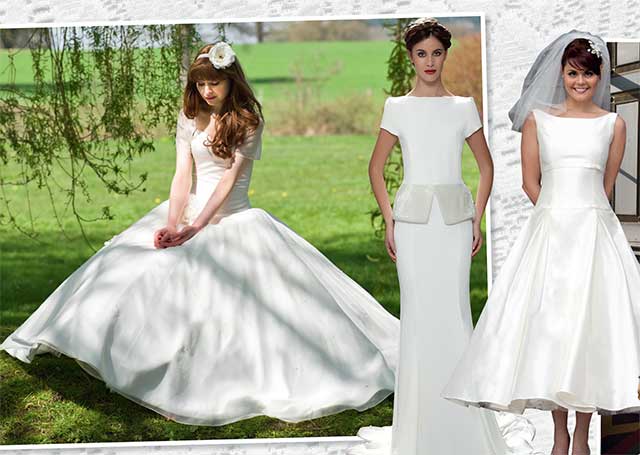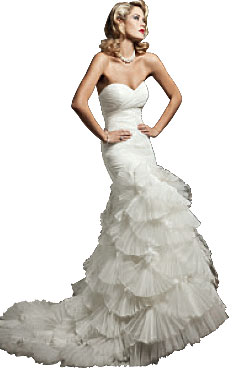
Words by Emma Langman
FABRIC OF LIFE
Every girl dreams of the gown she’ll wear on her wedding day – the look, the style, the colour. But not many of us can tell our duchess satin from our taffeta and chiffon. Yet the fabric used to make your dream dress is crucial, determining the feel, look and style of the gown overall. When you start your dress shopping, it’s worth considering the different fabrics available and which might best suit the style you want to achieve.
The predominant fabrics used in wedding dresses are lace, satin, silk, taffeta, tulle and chiffon. Each of these has qualities and attributes that make them better suited for certain tasks. “Designers employ a huge array of fabrics in their gowns, since each has a very distinctive look and structure that is used to achieve the desired effect,” explains Natalie Gladman, creator and designer at Madeline Isaac-James. “At Madeline Isaac-James, we use silk fabrics. The most popular silks are silk chiffon (which creates a soft, floaty, almost ethereal look), silk shantung and silk taffeta, which are very popular for gowns that require more structure.”
Bridal designer Joyce Young explains how to tell one fabric from another. “The best quality laces come from France and Belgium and these are used in couture dresses. Chantilly lace is delicate and feminine, while slightly heavier laces are corded, giving a more three-dimensional look and a bit more structure. You can tell a good lace by the scallop edge: there is a little fringe of threads finishing off the edge. Some people want to cut these off but they show that this is an authentic lace – it’s part of the beauty. Duchess satins are suitable for a more structured dress, while taffeta has a crisp papery feel and rustles when you walk. Tulle is see-through and used in layers to give a very floaty, romantic look. Chiffon is also transparent and fluid, making it suitable for flowing, unstructured styles. Georgette isn’t as see-through as chiffon but it can be made up into the same type of styles,” she says. [above: left, Shantung silk and silk organza Grace gown by Madeline Isaac-James, around £1649, stockists include Perfection Bridal and Menswear. Middle, Silk crepe Elizabeth dress, around £1650, Lara Hannah. Right, Silk zibeline Beautiful gown by Blue Bride, around £1950, stockists include Eleganza Sposa and Ivory Whites]
HOT TO CHOOSE
Even armed with this knowledge, it can be difficult to decide which will fabrics suit you best. Karen J. Mills, owner of The Wedding Planner bridal boutique, shares her advice on which fabrics are the most popular and why: “Brides love duchess satin because of its strength, beauty and feel – it gives a luxuriousness to the gown. Tulle is fluffy and romantic and reminds every bride of princesses and Cinderella’s last dance at the ball. Taffeta, meanwhile, has a luminosity and is very light. We have also seen the re-emergence of soft satin (also known as slipper satin), which gives a retro, vintage or sensual feel,” she explains.


Your venue or location might also have an effect on your choice of fabric, as heavier lace or duchess satin will give you less breathing room. For a summer celebration (or if you’re getting married abroad), try a chiffon or silk gown without any boning or underskirts – its lightweight nature will make you much more comfortable in a hot climate. If you’ve opted for a winter wedding, incorporating fabrics such as velvet or feathers will give a classic look in keeping with your celebration. [left: Organza gown (style 8639) by Justin Alexander, around £1560, stockists include The Wedding Planner and The Bridal Boutique]
LOVE THE LOOK
Each fabric lends itself well to a different wedding theme and style too. Lace gowns, increasingly popular since Kate Middleton made her appearance in one at the royal wedding, work well as part of a vintage theme, while structured duchess satin or taffeta will look fabulous in a traditional princess style or fishtail gown. “A princess-line dress (full A-line skirt or ballgown skirt) would work well using structured fabrics such as silk shantung or silk taffeta which will hold the shape beautifully,” explains Natalie Gladman. “To soften the look of the skirt, tulle or a silk chiffon can be used in layers on the skirt to create a very romantic look. Fishtails also need structure, so taffeta, shantung or dupion would work well.”
While you can spend hours looking through magazines and websites to get inspiration and ideas, the best way to discover which fabric suits you is to try them on for yourself. “Some dresses (and fabrics) will have more ‘hanger appeal’ than others – this does not mean that the dresses with less ‘hanger appeal’ won’t look stunning on!” advises Natalie Gladman.
Karen J. Mills recommends visiting bridal boutiques to get a (literal) feel of the gowns before you try them. “A good guide is what you like the feel of. If you don’t like to touch it, you won’t want to wear it!” she laughs.
You might have had a strong idea of which type of dress you see yourself walking down the aisle in, but keep an open mind until you’ve tried a few gowns on. Shunning a shantung gown purely on the basis of its fabric could stop you from finding ‘the one’. “It’s the combination of fabric, style, detail and colour that makes up a design, so it’s not a good idea to get fixated on which fabric does or doesn’t suit. A bride should always keep an open mind as there are unlimited ways of putting all these elements together and each designer uses her own handwriting to create new styles each season,” suggests Joyce Young.
DOING THE SUMS
Gown fabrics can differ widely in quality, and this also means a vast range of price points. Pure silk fabrics, for example, give a luxurious, feminine feel but can cost quite a bit more. There are lots of alternatives out there, though, mainly in the form of polyester variations. These might not feel quite so high quality but they can lend themselves well to the look you want to achieve – and sometimes at half the cost. “My advice is to choose the dress in the best quality fabric you can afford. No matter how much work goes into a dress, nothing can disguise a poor fabric,” advises Joyce Young.
(BSW:29)








